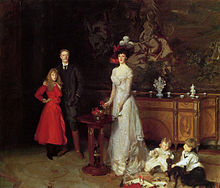George Sitwell

Sir George Reresby Sitwell, 4th Baronet (born January 27, 1860 in London - † July 9, 1943 in Locarno ) was a British non-fiction author and member of the British House of Commons between 1885 and 1895. He is mainly because of his three children Osbert , Edith and Sachverell , who were the center of an avant-garde cultural circle in London in the 1920s .
Life
George Sitwell was born in London. He was the son of Sir Sitwell Reresby Sitwell, 3rd Baronet, and his wife Louisa Lucy Hutchinson, daughter of the Hon. Henry Hely Hutchinson. Sitwell's father died in 1862, and George Sitwell inherited from him the title of Baronet , of Renishaw in the County of Derby, at the age of two.
Sitwell attended Eton College and studied at Oxford after graduating. He was a lieutenant in the West Yorkshire Yeoman. He was first elected to the British Parliament in 1885.
Sitwell was an avid collector of antiques and, among other things, worked on a family story. Among other things, he edited a volume, The Letters of the Sitwell and Dingverells . His collection of books and papers was so extensive that he was said to fill seven rooms in the large family estate of Renishaw Hall in Derbyshire . Sitwell, who was interested in horticulture and the historical development of gardens, dealt extensively with garden design during long trips to Italy and had the gardens of his family residence redesigned accordingly.
The reason for his long trips to Italy was his completely broken marriage. George Sitwell had asked for the hand of 17-year-old Ida Emily Augusta Denison after he had only met her twice at lunch. Until the wedding he was not aware that the lively daughter of Lord Londesborough and granddaughter of the 7th Duke of Beaufort , who corresponded to the ideal of beauty at the time, was probably mentally severely restricted due to an illness in childhood. She was barely able to write, was unable to multiply numbers and could not handle abstract values such as money and developed an alcohol addiction in the first years of their marriage. In a 1915 lawsuit, George Sitwell testified about his wife:

“She was 17 years old when I married her. It was obvious that her upbringing had been neglected, but I was sure that her mind and character would develop once she left her previous environment. However, since the beginning of the marriage, she has been completely incapable of appraising the value of money. She has never seen through business matters and is not aware of the commitments she takes on from time to time. "
Extremely wasteful, Ida went into debt again and again and spent three months in prison in 1915 after George Sitwell had refused to pay her debts after a particular excess. Although George Sitwell tried to avert this sentence after the conviction, this was no longer possible. A divorce would have led to social exclusion. All three of the couple's children suffered considerably from their parents' difficult relationship and showed solidarity with one of the two spouses at an early age. The mother's imprisonment strengthened the solidarity of the three siblings Edith, Sacherevell and Osbert. In the case of his eldest son and heir Osbert, the incident increased hatred of his father.
In 1909 George Sitwell bought the Castello di Montegufoni near Florence, which was largely destroyed. Over the next three decades he rebuilt this Italian palace according to the original design and lived there from 1925. He explained to the Archbishop of Canterbury and the British treasurer that he was leaving Great Britain with the high taxes to which he was subject. He stayed in Italy even after the outbreak of World War II, but moved to Switzerland in 1942 and died there in Locarno in 1943 at the age of 83. He was a British baronet for 81 years and 89 days, longer than his three predecessors combined and one of the longest times that any person has been allowed to adorn himself with this title.
literature
- Sarah H. Bradford: The Sitwells: And the Arts of the 1920s and 30s , National Portrait Gallery, ISBN 1-85514-141-8
- John Pearson: The Sitwells: A Family's Biography , Harvest Books (1980) ISBN 0-15-682676-3 .
- Desmond Sitwell: Renishaw Hall: The Story of The Sitwells . Elliott and Thompson Limited, London 2015, ISBN 978-1-78396-184-9 .
- Philip Ziegler: Osbert Sitwell , Chatto & Windus, London 1998.
Single receipts
- ^ Debrett's Guide to the House of Commons 1886
- ^ Tim Harris: Eccentric patriarch with slender grip on reality. In: The Age , January 2003, accessed March 6, 20126
- ^ Sitwell: Renishaw Hall: The Story of The Sitwells . P. 101
- ^ Sitwell: Renishaw Hall: The Story of The Sitwells . P. 153.
- ^ Sitwell: Renishaw Hall: The Story of The Sitwells . P. 154.
- ^ Sitwell: Renishaw Hall: The Story of The Sitwells . P. 155.
| predecessor | Office | successor |
|---|---|---|
| Sitwell Sitwell | Baronet (of Renishaw) 1862-1948 |
Osbert Sitwell |
| personal data | |
|---|---|
| SURNAME | Sitwell, George |
| ALTERNATIVE NAMES | Sitwell, Sir George Reresby, 4th Baronet |
| BRIEF DESCRIPTION | British non-fiction author and parliamentarian |
| DATE OF BIRTH | January 27, 1860 |
| PLACE OF BIRTH | London |
| DATE OF DEATH | July 9, 1943 |
| Place of death | Locarno |